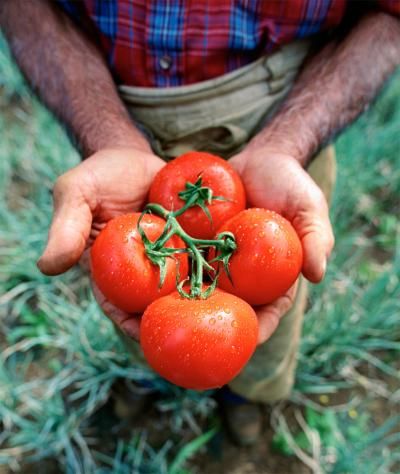Avoiding Common Tomato Problems — Growing Great Tomatoes
With our tips for avoiding common tomato problems, you’ll be growing great tomatoes in no time. Read on, and start planting!
 |
| Always water your tomatoes from the bottom and never from above. |
Starting your plants
Tomatoes can be a staple of any summertime meal, but they do come with a little extra work attached. Here are some tips to keep you sane through the growing season.
When starting tomatoes it's important to create an environment that will help get the plant established. Doing the right thing from the start will help immensely in the future. Soil conditions are a huge part of growing quality tomatoes. Tomatoes generally like a soil pH of between 5.5 and 7.5.
Simple testsare available in the Lawn and Garden department to see what level you're dealing with. If your soil is too acidic (low pH) lime should be applied, if it's too alkaline (high pH) soil sulfur should be applied to neutralize. A loose amended organic soil mix will produce high yields. A mixture like the Gertens Garden Mix of soil, compost, manure and peat moss is ideal.
A Little Extra Work Goes a Long Way
Mulching around tomatoes is perhaps the most overlooked (and important) part of growing quality tomato plants. Mulching with (herbicide-free) grass clippings, straw, or
fabric will not only keep the weeds out, but also prevent blight. Tomato Blights live in the soil and hurt the plants when that soil bounces up and hits the bottom leaves. Mulching around the stalk and out a few feet will help to prevent blight from ruining your crop.
What's wrong with my tomatoes?
By no means is this a complete list of tomato problems, but knowing a little information about tomatoes now can prevent a lot of google searches for "black spots on tomatoes" later.
Blight
If you notice your bottom leaves turning yellow and brown with spots of black there's a good chance you've already been infected with a blight. To be sure, bring a sample to our Lawn and Garden employees for an identification. Pick infected leaves off and spray the rest of the plant with a
copper fungicide to prevent the blight from spreading (wash hands and tools before touching another plant). Always water at the base of the plant and never from above. Proper watering will ensure happy, blight-free tomatoes.
Blossom End Rot
You've spent your summer mulching, watering, and fertilizing, the time is finally here. You've worked hard for this moment. Cherish it. You pick your perfect tomatoes and that's the moment the anger sets in. The bottom of your tomatoes are black... You gave them enough sun. You mulched. You watered from the bottom. You did everything right. Well, sort of. Fertilizing tomatoes correctly is another important step. Blossom End Rot is caused by a calcium deficiency. To prevent Blossom End Rot, use a fertilizer with a good amount of calcium. We recommend
Tomato Maker.
Insects
Well, it looks like you're not the only one who thinks tomatoes are delicious. Bugs like tomatoes too. There are some easy and safe fixes. For spraying the insects we like a product called Captain Jack's Deadbug by Bonide. It's natural, and best of all, it works. Another option to get rid of aphids and small insects is to put lady bugs in your garden (we have them in store for you here at Gertens). They eat the aphids and not the plants.

